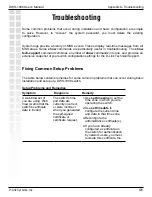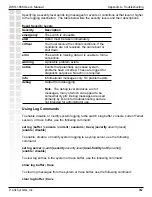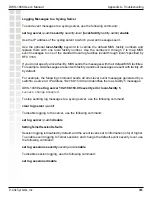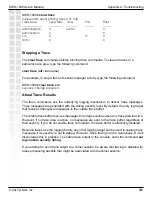
376
DWS-1008 User’s Manual
D-Link Systems, Inc.
Managing System Files
Backing Up and Restoring the System
MSS has commands that enable you to easily backup and restore system and user files:
backup
system
[
tftp:/
ip-addr
/
]
filename
[
all
|
critical
]
restore
system
[
tftp:/
ip-addr
/
]
filename
[
all
|
critical
] [
force
]
The
backup
command creates an archive in Unix
tape archive
(
tar
) format.
The
restore
command unzips an archive created by the
backup
command and copies the
files from the archive onto the switch. If a file in the archive has a counterpart on the switch,
the archive version of the file replaces the file on the switch. The
restore
command does not
delete files that do not have counterparts in the archive. For example, the command does
not completely replace the user files area. Instead, files in the archive are added to the user
files area. A file in the user area is replaced only if the archive contains a file with the same
name.
You can create or unzip an archive located on a TFTP server or in the switch’s nonvolatile
storage. If you specify a TFTP server as part of the filename with the
backup
command, the
archive is copied directly to the TFTP server and not stored locally on the switch.
Both commands have options to specify the types of files you want to back up and restore:
•
critical
- Backs up or restores system files, including the configuration file used when
booting, and certificate files. The size of an archive created by this option is generally
1MB or less. This is the default for the
restore
command.
•
all
- Backs up or restores the same files as the
critical
option,
and
all files in the user
files area of nonvolatile storage. (The user files area contains the set of files listed
in the
file
section of
dir
command output.) Archive files created by the
all
option are
larger than files created by the
critical
option. The file size depends on the files in the
user area, and the file can be quite large if the user area contains image files. This is
the default for the
backup
command.
Note: If the archive’s files cannot fit on the switch, the restore operation fails. D-Link
recommends deleting unneeded image files before creating or restoring an archive.
Use the
critical
option if you want to back up or restore only the system-critical files required
to operate and communicate with the switch. Use the
all
option if you also want to back up or
restore WebAAA pages, backup configuration files, image files, and any other files stored in
the user files area of nonvolatile storage.
Neither option archives image files or any other files listed in the
Boot
section of
dir
command
output. The
all
option archives image files only if they are present in the user files area.
The
backup
command stores the MAC address of the switch in the archive. By default, the
restore
command works only if the MAC address in the archive matches the MAC address of
the switch where the
restore
command is entered. The
force
option overrides this restriction
and allows you to unpack one switch’s archive onto another switch.
Summary of Contents for DWS-1008
Page 1: ......
















































